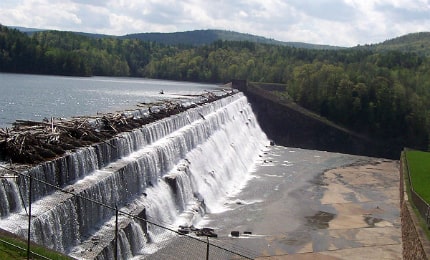
New York has around seven thousand dams, most of which were built over a century ago. However, due to the wear and tear, the authorities reconstructed many of these dams, and the Gilboa dam is one of them. With a rich history of more than a hundred years and many recreational activities, the Gilboa dam remains one of New York’s most prominent dams to this day.
The Gilboa Dam: Building and Reconstruction
The Gilboa dam is owned by the New York City Department of Environmental Protection (NYCDEP), and the project officially started in 1919. The dam is built on the Schohaire Reservoir, which covers stores around 19 million gallons of water, accounting for almost 15% of New York City’s daily domestic water requirements.
Furthermore, the Dam Concerned Citizens Incorporation was formed with a group of citizens to monitor the dam structure.
The dam is 120 feet high and consists primarily of stone brick and concrete. The dam was constructed in 1927, but due to the constant wear and tear, the dam was at constant risk of breaking and flooding nearby towns such as Conesville and Gilboa.
The problem was so severe that Schoharie County started a Gilboa Dam Failure Outdoor Warning System, which consisted of Mid-state communication in the event of the dam breaking. The system included twenty warning sirens covering Gilboa’s towns to Esperance and finally ended at the Montgomery County Line.
Hence, in 2005, the NYCDEP announced a $24 million project to repair the dam to meet the necessary safety standards. The work on fixing the dam officially began in late 2006 and consisted of installing 80 post-tensioned anchoring cables in the bedrock below the dam. However, this was a temporary fix, and many residents complained about brown water in their taps.
Hence, the NYCDEP authorized a complete reconstruction in 2011 with a funding of $350 million. The project involved repairing the walls, installing floodgates, and installing a bypass tunnel to allow the water to be released safely back into Schoharie Creek.
All About the Schoharie Reservoir
The Schoharie reservoir is located in the Catskill mountains and impounds on Schoharie Creek and covers 1112 acres. The reservoir is located 110 miles northwest of New York City and 36 miles southwest of Albany, on the southern end of Schoharie County.
The reservoir was created to find a new water supply after the Ashokan reservoir proved insufficient for New York’s domestic needs.
The construction started in 1919, was completed in 1924, and was put into service in 1926. Now, the 140 feet deep reservoir holds up to 18 billion gallons of water at total capacity and provides around 15% of New York City’s drinking water.
While the reservoir fixed the impending water supply issue, it came with a high cost of large-scale deforestation and relocation of the Gilboa village to the west.
The water from the reservoir flows through a 16-mile tunnel (Shandaken Tunnel) to reach New York City and empties into Esopus Creek.
The Gilboa Dam Flooding
Despite the many efforts taken by the authorities to ensure safety, the dam flooded in 2011 because of heavy rainfall due to Hurricane Irene, placing the dam at a level B emergency.
Heavy rainfall led to a large-scale evacuation of nearby towns such as Middleburgh and Schohaire. With the hurricane and the earthquakes that occurred the week preceding, the people of Schohaire were left uneasy. However, then governor Andrew Como visited the dam and assured people that the dam did not suffer any damages and the flooding occurred not because of the dam’s failure but due to the heavy rainfall.
The Blenheim-Gilboa Hydroelectric Power Station
As a dam, the primary purpose of the Gilboa Dam is to create hydroelectric power. The Blenheim-Gilboa hydroelectric power station is a pumped-storage plant that can generate up to 1100 megawatts of electricity with a capacity of around 12,000 megawatt-hours and can store more than 17000 megawatt-hours.
Recreational Activities at Gilboa
Gilboa offers visitors many recreational activities, mainly at the Schohaire reservoir.
The most prominent activity that people take part in is fishing. There are many different fish species you will find in the area, including Alewife, Yellow Perch, White Perch, Walleye, Rainbow Trout, Brook Trout, Common Carp, Emerald Shiner, Common Shiner, Spottail Shiner, Spotfin Shiner, Cluntose Minnow, Chain Pickerel, Rock Bass, Smallmouth Bass, Bluegill, Pumpkinseed, Brown Bullhead, Rudd, and White Sucker.
To fish in the Schohaire reservoir, you require an access permit from the NYCDEP and can only use tow boats that will be inspected. Motor boats and gasoline power boats are prohibited in the reservoir, and swimming in the reservoir is not allowed. Boating has been permitted in the Schoharie Reservoir since 2021 and allows kayaks, sailboats, and canoes.
Another activity that is popular near Gilboa is hunting. However, you must follow specific regulations. Deer hunting is allowed in October for bows and in November for rifles. The season for deer hunting ends in the first week of December. You can also hunt bears, turkeys, bobcats, and small creatures in designated seasons.
For a quieter activity, Gilboa is known for its museum that shows a variety of fossils and various historical pieces on display from the Devonian period, an era before dinosaurs.
Additionally, the Blenheim-Gilboa visitors centers display features demonstrating the science behind electricity and energy, and admission to the visitor center is free.
Entry into the Gilboa dam is prohibited, but you can visit the Gilboa dam overlook by taking the NYC-30 route 990V. For a detailed look at the location, you can see the map here.
To Conclude
The Gilboa Dam has a rich history and serves as more than just a hydroelectric power plant or a water storage facility. While it has been through a lot, the dam stands firm in its place and continues to serve its many purposes for the people of New York.
